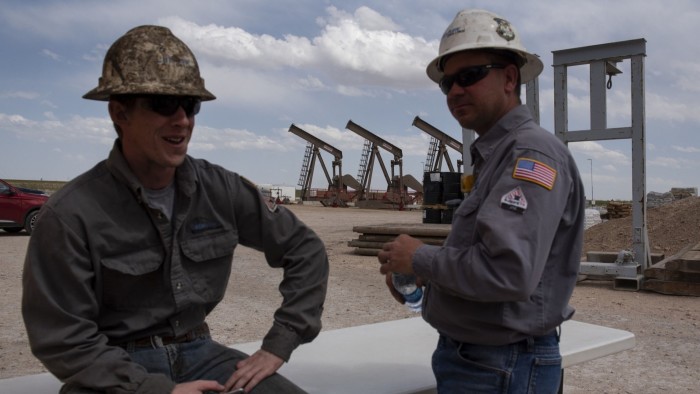US oil executives are eagerly awaiting Donald Trump’s expected rollback of environmental regulations, but despite the president’s pledge to “drill, baby, drill”, production is unlikely to increase significantly during his second term in office.
Trump made energy policy a pillar of his campaign, vowing to slash red tape and unshackle US oil producers to drive up production and bring down prices for consumers.
“We have more liquid gold than any country in the world — more than Saudi Arabia,” Trump said as he claimed victory early on Wednesday morning.
The former president’s re-election is a boon for the industry, which had a tumultuous relationship with Joe Biden’s administration. It is also a big pay-off for the corporate leaders who poured money into his campaign war chest.
“I couldn’t be more thrilled by president-elect Donald Trump’s victory,” said Continental Resources founder Harold Hamm, a Trump donor. “This is a monumental win for American energy and the future of our nation’s security.”
Jeff Miller, chief executive of Halliburton, one of the country’s biggest oilfield service companies, echoed those sentiments. “It could only be positive. In fact, I’m quite optimistic,” he said.
On taking office next January, the industry expects Trump to slash many of the environmental rules imposed by Biden. Mike Sommers, head of the American Petroleum Institute, said there had been a “regulatory onslaught” during the past four years that would now be reversed.
“Just the signal from the administration that they want a robust oil and gas industry in the US is going to be a major component to getting this industry the investment that it needs to continue to grow,” he said.
Among the changes the industry expects are the abolition of rules on tailpipe emissions designed to push motorists towards electric vehicles, as well as expanded access to hydrocarbons through increased leasing in the Gulf of Mexico and on public lands, and the dilution of protections for endangered species. Trump is also predicted to end a pause on new licences for liquefied natural gas terminals.
Trump has vowed to slash corporate tax and unpick Biden’s signature climate legislation, the Inflation Reduction Act. But many in the industry benefit from the IRA and are lobbying against its wholesale removal.
Trump has already begun to shape the team that will be responsible for making these changes. North Dakota governor Doug Burgum is in contention for a new “energy tsar” role that will co-ordinate the deregulatory drive across a patchwork of government agencies.
But despite the anticipated regulatory overhaul, analysts warned that a rapid increase in output during Trump’s second term was unlikely. Production has hit record levels during Biden’s term in office, reaching a fresh high of 13.4mn barrels a day in August despite the regulations.
But investors — burnt after years of debt fuelled drilling binges — are keen for companies to prioritise returns over growth. The model of capital discipline they have imposed on the sector is unlikely to change.

“Price and Wall Street are the regulators of US production, not the president,” said Jim Burkhard, head of research for oil markets at consultancy S&P Global.
Production is set to average about 13.2mn barrels a day this year, according to S&P, rising to 13.6mn b/d in 2025 before probably slipping the following year, driven by lower prices. Trump’s re-election does not change its near term outlook.
Macroeconomic factors, however, may help Trump keep his promise to bring down prices at the pump: sluggish Chinese demand coupled with Opec+ plans to increase supplies are likely to depress prices in the months ahead. But that would have a negative impact on oil producers.
“The market is oversupplied because the Chinese economy is not delivering the kind of demand that it has in the past,” said Daniel Yergin, a Pulitzer Prize-winning energy historian and author of The New Map. “That is the biggest overhang for the global and US oil industry.”
Bob McNally, president of consultancy Rapidan Energy and a former energy adviser to the George W Bush administration, said that while “any president has very limited tools to impact the price of oil in the short term” if strong global supply growth outpaces demand in the coming years, Trump “may get lucky and witness a sharp decline in oil prices”.
“However, he would relearn a lesson from 2020, which is that low oil prices may please consumers, but they also hurt the US shale oil sector,” he said. “In fact the biggest threat to the US shale sector is sharply lower oil prices.”
Trump showed during his first term he was willing to play an active role in shaping the oil price. In 2018, he browbeat Opec into increasing production to bring down prices at the pump, before convincing them to slash it in 2020 to save the US shale patch from bankruptcy as prices plunged in the wake of the coronavirus pandemic.
Trump has also vowed to exert maximum pressure on Iran, ramping up sanctions on its oil exports, which could push up the global oil price.
One of the most fundamental changes sought by the industry is for Trump, aided by Republican control of the Senate and potentially the House of Representatives, to push through far reaching permitting reform legislation after years of failed attempts.
Alan Armstrong, head of pipeline giant Williams said he was “very hopeful with more Republican control that the permitting issue finally gets dealt with in a durable and meaningful way”.
Despite Trump’s plans to tear up environmental rules, analysts expect large public oil companies to remain motivated to curb emissions — especially when it comes to methane, a potent greenhouse gas.
“I think the expectation that they will be reducing emissions and investing in clean energy does not go away because Donald Trump was elected,” said Paul Bledsoe, a former climate adviser to the Bill Clinton administration.
“I think that’s a public expectation. That’s an investor expectation.”
https://www.ft.com/content/e66338d6-ac4d-4387-a07b-c17c252b2189


